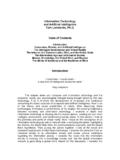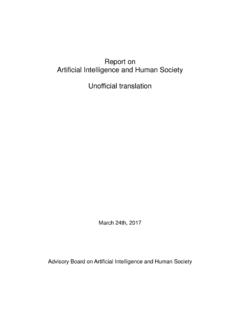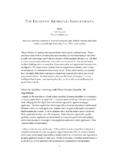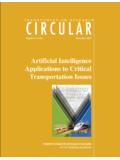Transcription of Artificial intelligence and behavioral economics - …
1 1 Artificial intelligence and behavioral economics Colin F. Camerer Caltech 12/21/17 PST. For NBER volume (Editors A. Agarwal, J. Gans, A. Goldfarb). I: Introduction This paper describes three highly speculative ideas about how Artificial intelligence (AI) and behavioral economics may interact, particular in future developments in the economy and in research frontiers. First note that I ll use the terms AI and machine learning (ML) interchangeably (although AI is broader) because the examples I have in mind all involve ML and prediction. A good introduction to ML for economists is Mullainathan and Spiess (2017), and other papers in this volume.
2 The first idea is that ML can be used in the search for new behavioral -type variables that affect choice. Two examples are given, from experimental data on bargaining and on risky choice. The second idea is that some common limits on human prediction might be understood as the kinds of errors made by poor implementations of machine learning. The third idea is that it is important to study how AI technology used in firms and other institutions can both overcome and exploit human limits. The fullest understanding of this tech-human interaction will require new knowledge from behavioral economics about attention, the nature of assembled preferences, and perceived fairness.
3 II: Machine learning to find behavioral variables 2 behavioral economics can be defined as the study of natural limits on computation, willpower and self-interest, and the implications of those limits for economic analysis (market equilibrium, IO, public finance, etc.). A different approach is to define behavioral economics more generally, as simply being open-minded about what variables are likely to influence economic choices. This open-mindedness can be defined by listing neighboring social sciences that are likely to be the most fruitful source of explanatory variables.
4 These include psychology, sociology ( , norms), anthropology (cultural variation in cognition), neuroscience, political science,, etc. Call this the behavioral economics trades with its neighbors view. But the open-mindedness could also be characterized even more generally, as an invitation to machine-learn how to predict economic outcomes from the largest possible feature set. In the trades with its neighbors view, features are constructs that are contributed by different neighboring sciences. These could be loss-aversion, identity, moral norms, in-group preference, inattention, habit, model-free reinforcement learning, individual polygenic scores, etc.
5 But why stop there? In a general ML approach, predictive features could be and should be-- any variables that predict. (For policy purposes, variables that could be controlled by people, firms and governments may be of special interest.) These variables can be measurable properties of choices, the set of choices, affordances and motor interactions during choosing, measures of attention, psychophysiological measures of biological states, social influences, properties of individuals who are doing the choosing (SES, wealth, moods, personality, genes), and so forth.
6 The more variables, the merrier. From this perspective, we can think about what sets of features are contributed by different disciplines and theories. What features does textbook economic theory contribute? Constrained utility-maximization in its most familiar and simple form points to only three kinds of variables prices, information (which can inform utilities) and constraints. 3 Most propositions in behavioral economics add some variables to this list of features, such as reference-dependence, context-dependence (menu effects), anchoring, limited attention, social preference, etc.
7 Going beyond familiar theoretical constructs, the ML approach to behavioral economics specifies a very long list of candidate variables (=features) and include all of them in an ML approach. This approach has two advantages: First, simple theories can be seen as bets that only a small number of features will predict well; that is, some effects (such as prices) are hypothesized to be first-order in magnitude. Second, if longer lists of features predict better than a short list of theory-specified features, then that finding establishes a plausible upper bound on how much potential predictability is left to understand.
8 The results are also likely to create raw material for theory to figure out how to consolidate the additional predictive power into crystallized theory (see also Kleinberg, Liang, and Mullainathan 2015). If behavioral economics is recast as open-mindedness about what variables might predict. Then ML is an ideal way to do behavioral economics because it can make use of a wide set of variables and select which ones predict. I ll illustrate it with some examples. Bargaining: There is a long history of bargaining experiments trying to predict what bargaining outcomes (and disagreement rates) will result from structural variables using game-theoretic methods.
9 In the 1980s there was a sharp turn, in experimental work, towards noncooperative approaches in which the communication and structure of bargaining was carefully structured ( , Roth1995, and Camerer, 2003 for reviews?. In these experiments the possible sequence of offers in the bargaining are heavily constrained and no communication is allowed (beyond the offers themselves). This shift to highly structured paradigms occurred because game theory, at the time, delivered sharp, nonobvious new predictions about what outcomes might result depending on the structural parameters particularly, costs of delay, time horizon, the exogenous order of offers 4 and acceptance, and available outside options (payoffs upon disagreement).)
10 Given the difficulty of measuring or controlling these structural variables in most field settings, experiments provided a natural way to test these structured-bargaining theories. 1 Early experiments made it clear that concerns for fairness or outcomes of others influenced utility, and the planning ahead assumed in subgame perfect theories is limited and cognitively unnatural (Camerer et al 1994; Johnson et al 2002; Binmore et al 2002). Experimental economists became wrapped up in understanding the nature of apparent social preferences and limited planning in structured bargaining.













